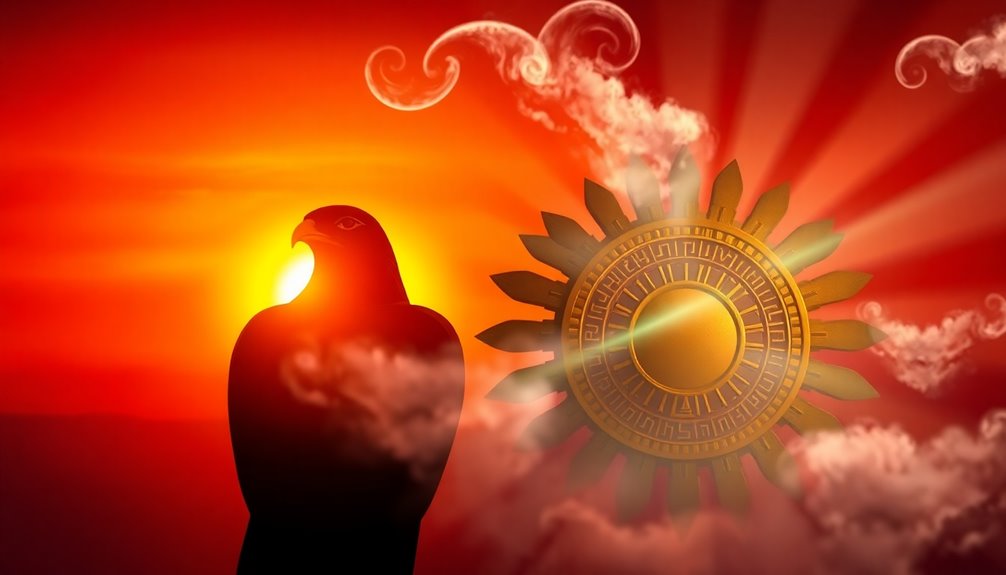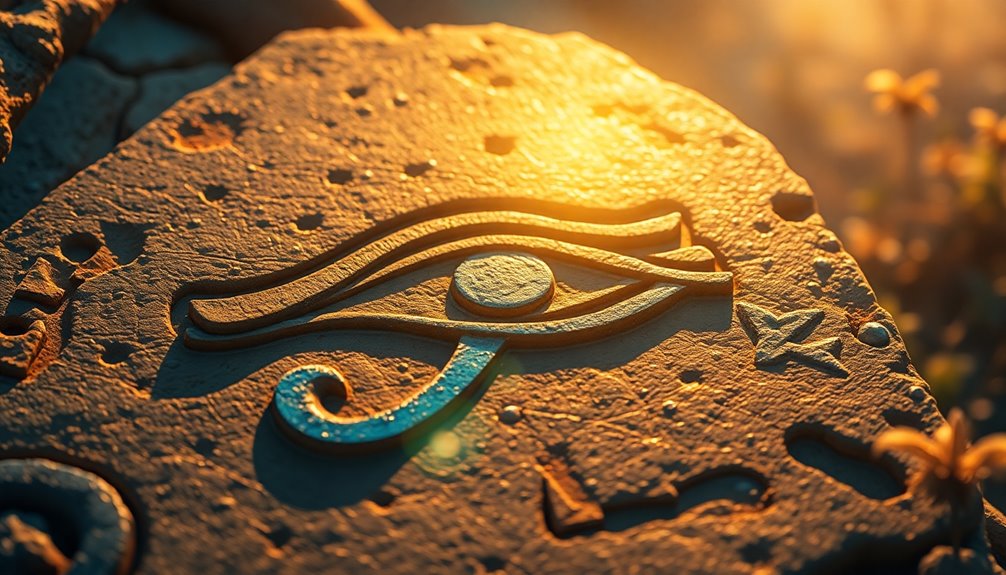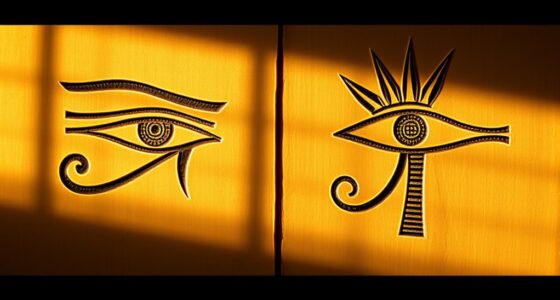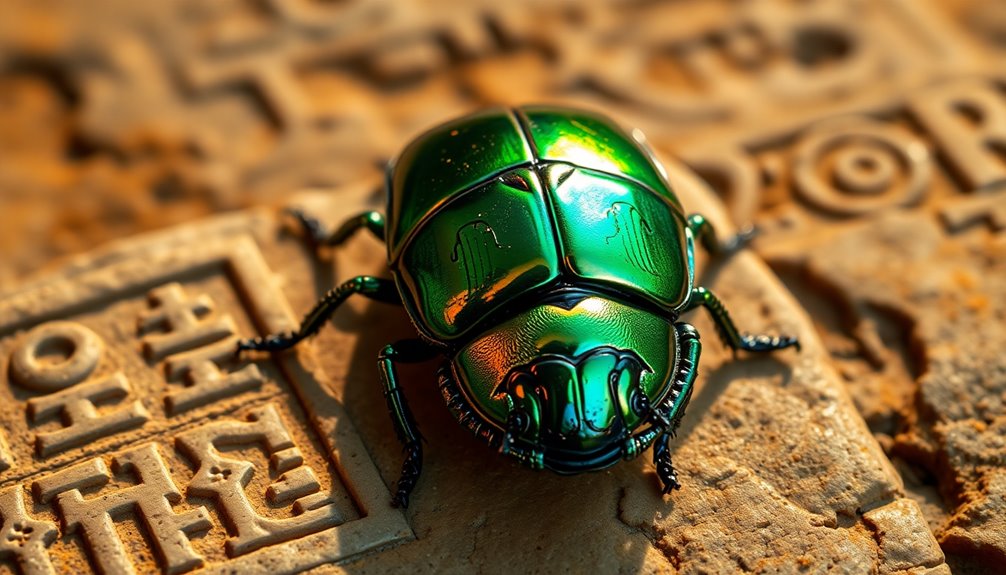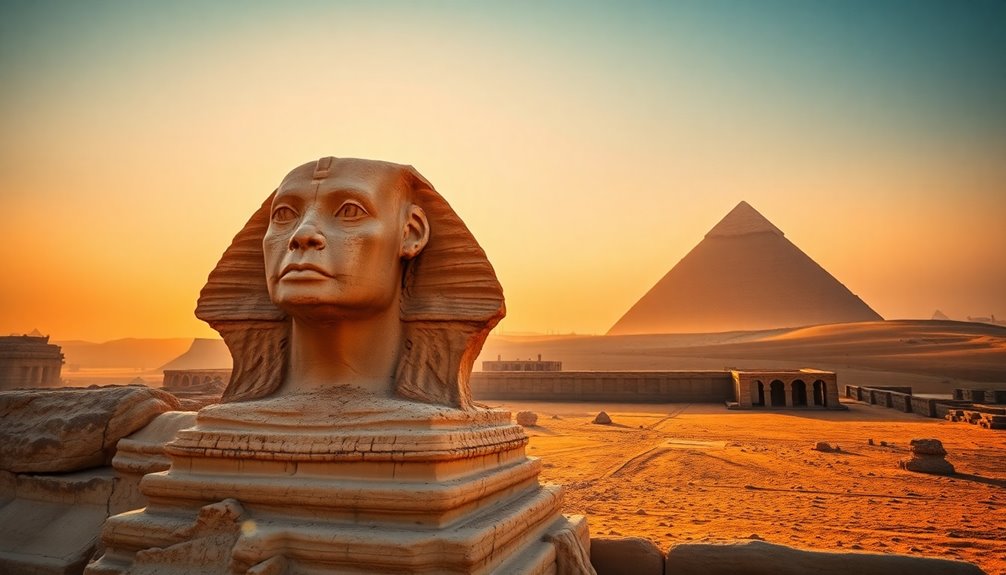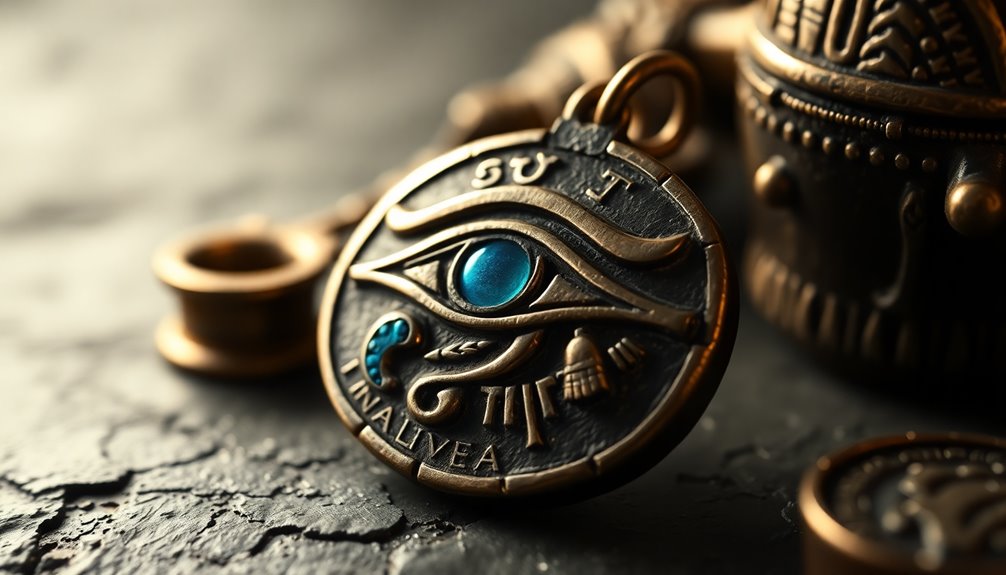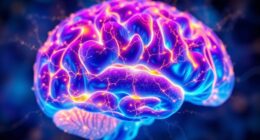Horus and Ra are deeply intertwined in ancient Egyptian mythology. You might be surprised to learn that they symbolize kingship and life itself. Horus represents protection for pharaohs with his falcon-head, while Ra, the sun god, governs the cycles of life and death. Their connection is clear in the composite deity Ra-Horakhty, merging their powers. As Horus battles chaos and Ra journeys across the sky, both embody themes of justice and renewal. This relationship not only reflects divine kingship but also enriches cultural rituals, linking their legacies in fascinating ways. Discover more about their intriguing connections and shared narratives!
Key Takeaways
- Horus and Ra are both central figures in Egyptian mythology, symbolizing kingship, protection, and life through their divine attributes.
- The composite deity Ra-Horakhty merges Horus's kingship with Ra's life-giving essence, illustrating the syncretism in Egyptian beliefs.
- Horus, as the son of Osiris and Isis, embodies the divine right to rule, while Ra represents the cyclical nature of creation and renewal.
- Their narratives emphasize the battle between order and chaos, with Horus defeating Set and Ra battling Apep to restore cosmic balance.
- The Eye of Horus symbolizes protection and restoration, connecting both gods' legacies to modern spirituality and cultural expressions.
Overview of Horus and Ra
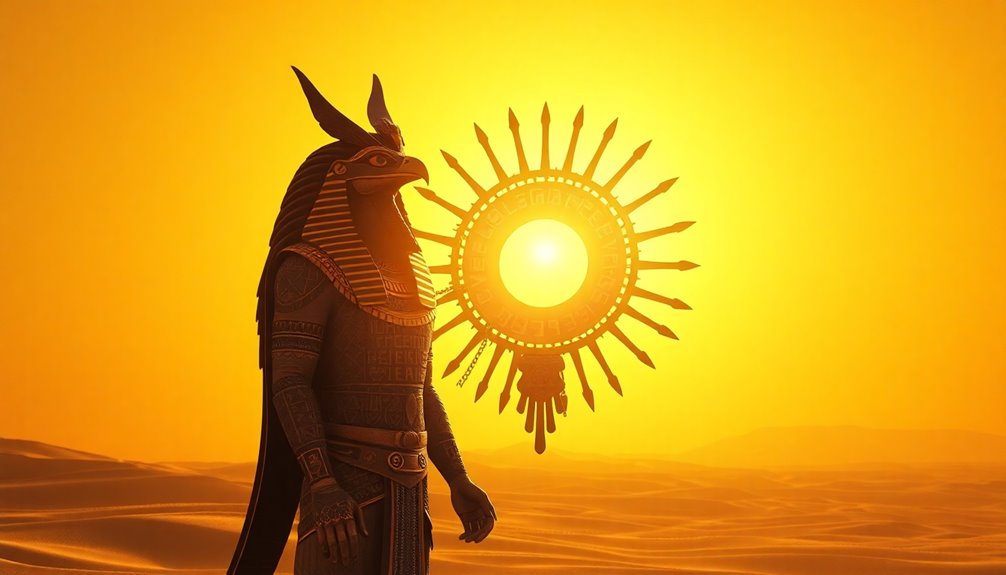
Horus and Ra, two pivotal figures in ancient Egyptian mythology, embody distinct yet interconnected aspects of life and power. As the falcon-headed god, Horus represents kingship and the sky, symbolizing the protection of pharaohs. His mythology highlights the struggle between light and darkness, aligning closely with Ra, the sun god and creator deity.
Ra governs the cycle of life and death through his daily journey across the sky, battling the serpent Apep, a representation of chaos.
In Egyptian mythology, both gods serve vital roles, with Horus symbolizing the protective force for rulers and Ra signifying the life-giving essence of the sun. Their connection is further illustrated by the composite deity Ra-Horakhty, showcasing the syncretism prevalent in the beliefs of ancient Egypt.
This merging emphasizes their shared importance as cosmic deities, with Horus's left eye linked to lunar powers and his right eye representing Ra's solar might.
Together, these gods of ancient Egypt reflect a rich tapestry of beliefs, where the themes of light, protection, and the eternal struggle against chaos intertwine, revealing the depth of their significance in the ancient world.
Birth and Family Connections

The intricate birth and family connections between Horus and Ra highlight their significant roles in ancient Egyptian mythology. Horus, the son of Osiris, the god of the Afterlife, and Isis, the goddess of healing, was conceived during Osiris's resurrection. This essential connection establishes Horus as a key figure within the Egyptian pantheon.
Ra, often viewed as a father figure to many gods, plays an important role in the divine lineage, representing the sun and the themes of kingship intertwined with Horus's mythology.
Both gods symbolize kingship in distinct ways. Horus serves as the protector of the pharaohs, while Ra embodies the divine right to rule as the sun god. The merging of their identities into the composite deity Ra-Horakhty showcases the syncretism prevalent in Egyptian mythology, linking their attributes as solar and sky gods.
Horus's birth narrative is marked by celestial events, with the star Sirius heralding his arrival. This connection parallels Ra's association with the sun and cosmic phenomena, emphasizing their intertwined destinies and shared significance in the mythological landscape of ancient Egypt.
Domains and Symbolism
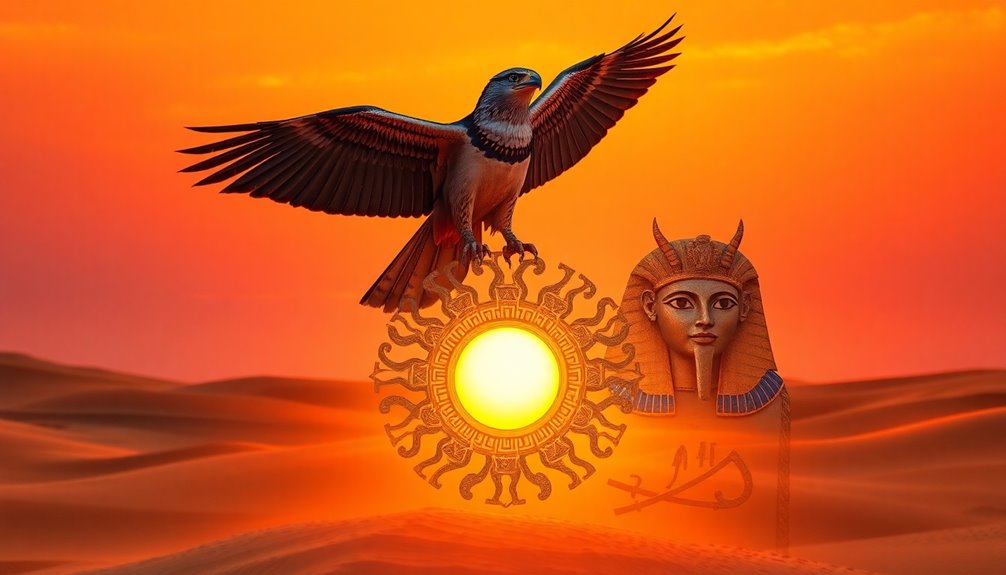
When you explore the domains of Ra and Horus, you'll find a fascinating interplay of solar authority and kingship symbolism.
Ra, as the sun god, embodies the cycles of light and life, while Horus represents rightful rule and the protection of the pharaohs.
Together, they illustrate the deep connection between the divine and the earthly in ancient Egyptian belief.
Ra's Solar Authority
Ra, often regarded as the chief deity of ancient Egyptian mythology, holds unparalleled solar authority that encompasses the domains of creation, light, and life. His daily journey across the sky symbolizes the cycle of day and night, reinforcing the natural order. Represented with a falcon head and a prominent sun disk atop his head, Ra embodies the essence of solar authority, demonstrating his dominance in the Egyptian pantheon.
The mythology surrounding Ra highlights his crucial role in agriculture and fertility, as rituals dedicated to him reflect the rhythms of life, death, and rebirth. Temples like those at Heliopolis showcase his significance, where devotees celebrated his solar power through various festivals.
The merging of Ra with Horus into the composite deity Ra-Horakhty illustrates the syncretism in ancient Egyptian beliefs, emphasizing their shared attributes of solar energy and kingship. This combined representation further solidifies Ra's influence, linking him to the ongoing cycle of life and the natural world.
Through his unwavering solar authority, Ra remains an indispensable figure, revered for sustaining the existence and harmony of the universe.
Horus's Kingship Symbolism
Horus stands as a powerful symbol of kingship in ancient Egyptian mythology, embodying the divine right of pharaohs to rule. As the falcon-headed god, he represents legitimate authority and the rightful governance of Egypt. His double crown, the Pschent, signifies the unification of Upper and Lower Egypt, reinforcing his role as a protector of both regions.
The left and right eyes of Horus symbolize the Moon and the Sun, respectively, illustrating his connection to celestial bodies. This connection emphasizes his guardianship over the natural order, making him a crucial figure in maintaining balance and justice.
Horus's mythology often highlights themes of vengeance and justice, particularly in his conflict with Set, underscoring his protective nature against chaos.
The Eye of Horus, representing protection, healing, and restoration, became a powerful amulet associated with Horus's kingship. It symbolizes the pharaoh's divine protection and authority, making it a significant emblem in ancient Egypt.
Mythical Narratives and Themes
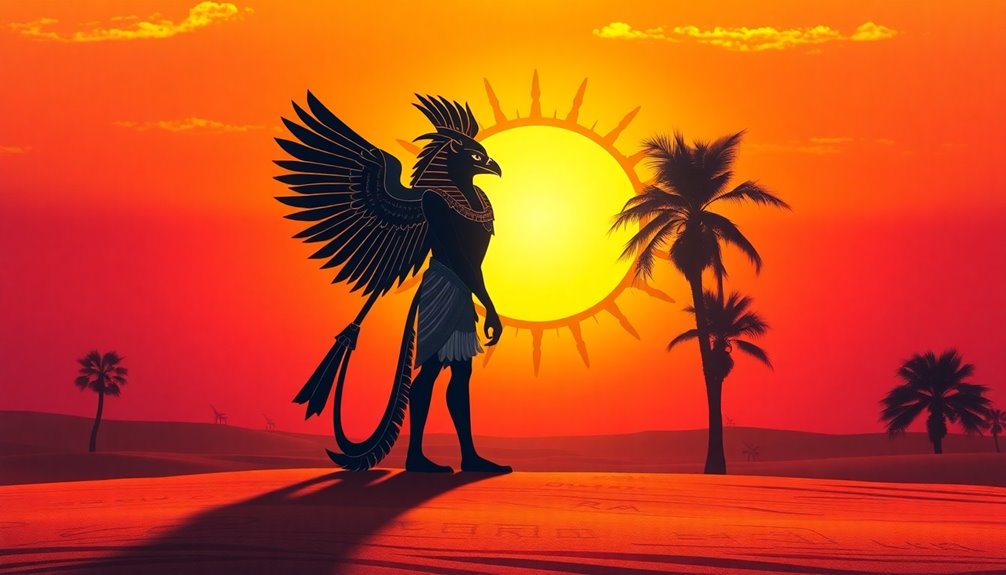
The tales of Horus and Ra weave together intricate narratives that reveal profound themes central to ancient Egyptian beliefs. Their stories encapsulate the essence of life, justice, and the eternal struggle between order and chaos.
- Ra's journey across the sky symbolizes life, death, and rebirth.
- Horus's vengeance for Osiris embodies justice and rightful leadership.
- The resurrection of Osiris by the goddess Isis showcases loyalty and divine restoration.
In Egyptian religion, Ra battles the serpent Apep, representing chaos, while Horus confronts Set, endeavoring to reclaim his father Osiris's throne. This duality emphasizes not just the importance of kingship, but also the moral fabric of society—justice must prevail.
The resurrection of Osiris by Isis sets the stage for Horus's rise, highlighting family loyalty intertwined with divine purpose.
As you explore these mythical narratives, you'll notice how Horus and Ra often merge into the figure Ra-Horakhty, symbolizing syncretism in Egyptian mythology.
These stories reflect societal values, illustrating the enduring battle between good and evil, and the necessity of maintaining order amidst chaos.
Cultural Significance and Influence
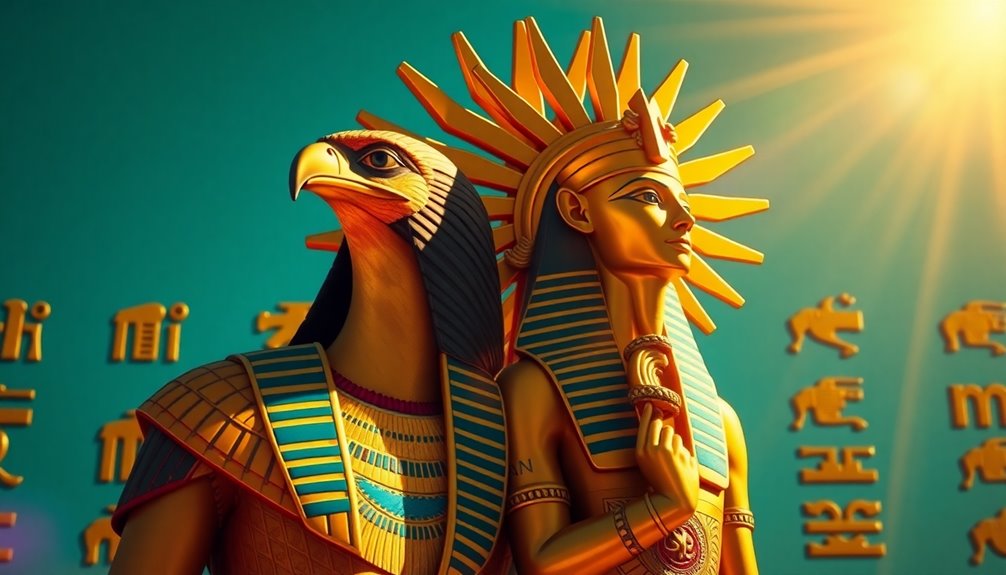
When you look at the relationship between Horus and Ra, you'll see a strong connection to divine kingship in ancient Egypt.
Their association shaped rituals and festivals that reinforced the pharaoh's authority and divine right to rule.
This integration into daily life highlights how these gods influenced not just the spiritual domain but also the socio-political landscape of their time.
Divine Kingship Association
Divine kingship in ancient Egypt is intricately tied to the powerful associations with gods like Horus and Ra. As a pharaoh, you'd embody the essence of Horus, the falcon-headed protector, reinforcing your divine kingship. Ra, the sun god, represents not just life but the ultimate authority, guiding you with his solar divinity as you navigate the complexities of leadership.
- Horus symbolizes protection and kingship, crucial for pharaohs.
- Ra's sunlight signifies life and legitimacy, essential for ruling.
- The combined deity Ra-Horakhty illustrates the unity of divine power.
Pharaohs often invoked both Horus and Ra to legitimize their reign, seeking the divine authority and protection these gods of Egypt offered. By associating themselves with such powerful deities, you'd affirm your right to rule, positioning yourself as a divine intermediary between the gods and your people.
The integration of Horus and Ra into one composite figure shows the deep connection between kingship and solar divinity, emphasizing how pivotal these beliefs were for maintaining order and stability in ancient Egyptian society.
Rituals and Festivals
Celebrating the gods Horus and Ra through various rituals and festivals played an essential role in ancient Egyptian culture, marking significant seasonal and agricultural events. One major celebration was the annual "Wepet-Renpet" festival, which welcomed the New Year and coincided with the flooding of the Nile River. This event was vital for agricultural prosperity, as it symbolized rebirth and renewal.
The "Horus Festival" emphasized the divine right of the pharaoh to rule, showcasing Horus's connection to kingship. During these rituals, the pharaoh would reaffirm his role as protector of the state, invoking Horus for guidance and strength.
On the other hand, Ra's daily journey across the sky was honored with processions and offerings, highlighting the significance of solar cycles in both agricultural and religious life. Festivals dedicated to Ra often included reenactments of mythological narratives, reinforcing his role as the creator deity and sustainer of life.
The integration of Horus and Ra into unified worship practices, such as the syncretic deity Ra-Horakhty, further illustrates their combined significance, strengthening the relationship between the gods and the pharaoh in ancient Egyptian society.
Conflict and Resolution
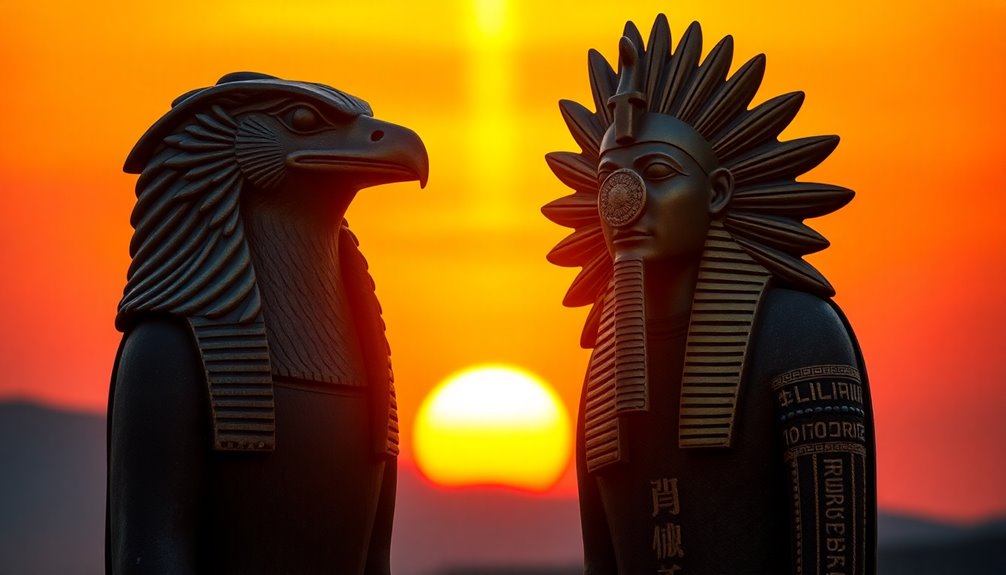
The conflict between Horus and Set is a pivotal moment in Egyptian mythology, where Horus's fierce determination to avenge his father, Osiris, drives the narrative forward. This epic struggle underlines the importance of protection and justice in the lives of the pharaohs.
- Horus embodies the rightful claim to the throne, representing divine kingship.
- Ra's support provides the strength Horus needs to confront chaos.
- The Eye of Horus symbolizes restoration and the triumph of light over darkness.
Horus's battle against Set isn't just a personal vendetta; it reflects a cosmic struggle between order and chaos. Ra, as the sun god and creator, guides Horus, ensuring he's the power to reclaim his father's legacy.
The merging of Ra and Horus into Ra-Horakhty further illustrates their connection, highlighting the sun's role in maintaining harmony. Through ritual and mythology, they embody the protection of the pharaohs.
In every victory, Horus reinstates maat, the principle of order, mirroring Ra's daily fight against Apep, the serpent of chaos. This conflict and resolution reinforce the divine right of pharaohs, ensuring harmony in the land of Egypt.
Legacy and Modern Interpretations
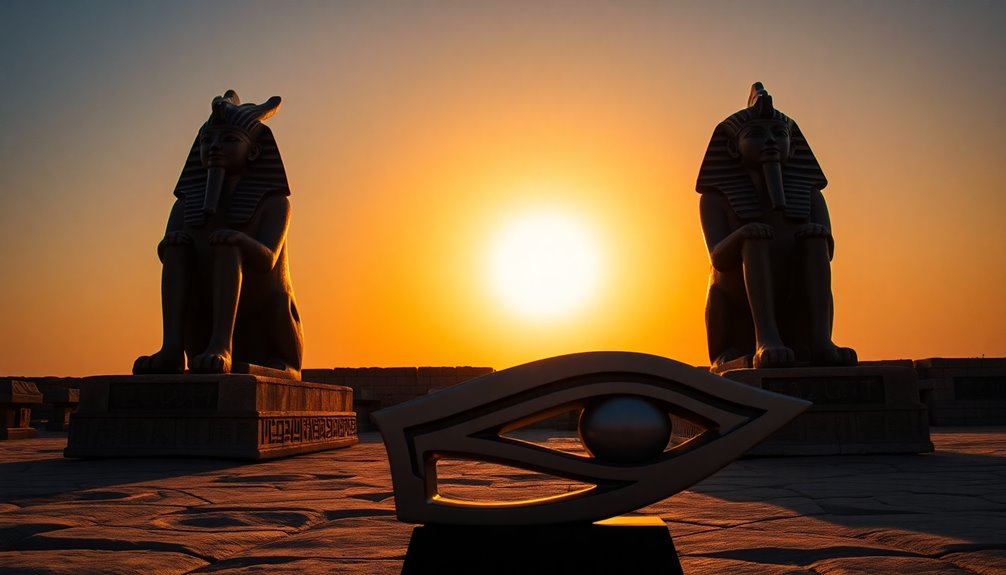
Exploring the legacy of Horus and Ra reveals their lasting impact on how we view divinity today. Both gods embody the essence of solar deities, representing not only the sun's physical journey across the sky but also the cyclical nature of life and death. Ra's daily ascent symbolizes renewal, a theme that resonates in various modern interpretations of spirituality and personal growth.
Horus, known for his protective qualities, has left a significant mark on popular culture. The Eye of Horus, a potent symbol of protection and healing, remains prevalent in contemporary art and jewelry, illustrating how ancient beliefs continue to influence modern aesthetics.
The syncretism of Horus and Ra into Ra-Horakhty showcases the blending of religious beliefs, inspiring discussions about divine identities in mythology today. Furthermore, their narratives are frequently referenced in literature and media, emphasizing themes of light versus darkness and the quest for justice—concepts that are deeply relevant in today's societal context.
In this way, the legacy of Horus and Ra persists, shaping our understanding of divinity and protection while inspiring spiritual exploration in the modern world.
Frequently Asked Questions
What Is the Connection Between Ra and Horus?
Ra and Horus share a deep connection in Egyptian mythology.
You'll find that Ra, as the sun god, embodies creation and life, while Horus symbolizes kingship and protection. Their merging into Ra-Horakhty emphasizes the unity of their powers.
You can see this in their roles in the afterlife, where Ra's daily journey across the sky represents the cycle of existence, and Horus's divine kingship guarantees the protection of pharaohs.
What Is the Connection Between the Egyptian God Ra and Other Gods?
You'll find that Ra connects with several other Egyptian gods, enhancing the complexity of their mythology.
For example, he often merges with Horus as Ra-Horakhty, combining their powers of kingship and the sun.
Additionally, Ra interacts with Osiris, the god of the afterlife, symbolizing the cycle of life and death.
Through these connections, Ra embodies not just sunlight but also governance, protection, and the eternal struggle between order and chaos in the universe.
What Is the Relationship Between Horus and Other Gods?
When you explore the relationship between Horus and other gods, you find a rich tapestry of connections.
He's the son of Osiris and Isis, tying him to the themes of resurrection and the afterlife.
His conflict with Set highlights the struggle between chaos and order.
You'll also see Horus merging with Ra, creating a powerful symbol of kingship and divine authority, underscoring his integral role in ancient Egyptian mythology and society.
How Can You Tell Horus and Ra Apart?
To tell Horus and Ra apart, focus on their depictions and symbolism.
Horus often appears as a falcon or a man with a falcon head, representing kingship and the sky. In contrast, Ra's commonly shown with a sun disk or a hawk head, embodying the sun and creation.
Their stories also differ; Horus avenges his father, while Ra governs life and death.
Remember these traits, and you'll easily distinguish between them.
Conclusion
In exploring the connections between Horus and Ra, you uncover a rich tapestry of mythology that binds ancient Egyptian culture. Did you know that over 3,000 years ago, Ra was worshipped as the sun god, representing life and creation, while Horus was seen as the protector of the pharaohs? This enduring legacy not only shaped religious practices but also inspired countless artistic representations. Together, they embody the celestial harmony that once guided an entire civilization's understanding of existence.

